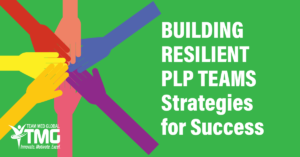
1. Define the Mission Beyond the Task List
Resilience starts with purpose. When PLPs understand how their work contributes to patient care, organizational success, and provider well-being, it becomes more than just paperwork. Make that connection visible. Use team meetings to spotlight the impact of timely enrollment or clean audits. Help your team see that they’re not just processing forms—they’re enabling access to care.
2. Cross-Train and Share Knowledge
Nothing creates vulnerability like siloed knowledge. When only one person knows how to manage payer X or access system Y, the team becomes brittle. Cross-training builds flexibility and coverage. Create process guides, encourage team shadowing, and rotate responsibilities when possible. This not only protects operations—it builds confidence and camaraderie.
3. Foster Psychological Safety
Resilient teams feel safe speaking up, asking questions, and sharing concerns. Create a culture where mistakes are treated as learning opportunities, not failures. If someone spots a process gap or needs help navigating a regulation, they should feel supported in saying so. Trust is the foundation of adaptability.
4. Prioritize Workload Management
Credentialing and enrollment are deadline-driven—but that doesn’t mean teams should operate in constant crisis mode. Track task volume and bandwidth. Adjust assignments when needed. Build in buffer time during high-volume periods like reappointment season. Encourage realistic time estimates, and say no to unrealistic expectations. Sustainable workloads support long-term resilience.
5. Build Systems for Feedback and Improvement
Resilient teams evolve. Create regular check-ins to discuss what’s working—and what’s not. Use short retrospectives after major projects to identify lessons learned. Encourage team members to share insights or suggest improvements to forms, checklists, or workflows. Giving people a voice in the process helps them stay engaged and invested.
6. Celebrate Wins, Big and Small
Whether it’s a successful audit, a smooth onboarding, or a reduced turnaround time—acknowledge it. Recognition reinforces resilience by reminding teams that their work matters and their effort is seen. Even a quick thank-you email or a shoutout in a team meeting can go a long way.
The Bottom Line
Resilience isn’t about pushing through at all costs—it’s about creating a foundation that allows PLP teams to adapt, recover, and grow. When you focus on purpose, process, and people, you create a team that’s not only operationally strong, but also energized, collaborative, and ready for whatever comes next.

